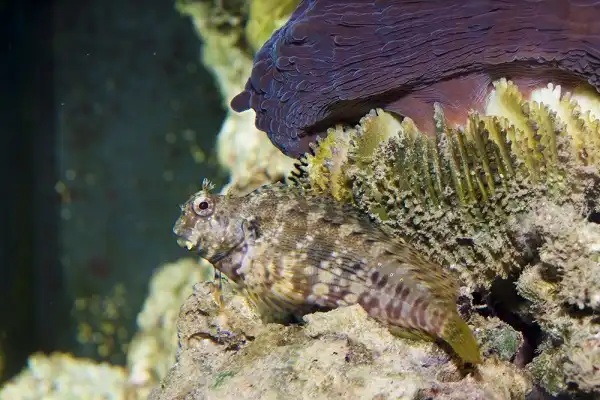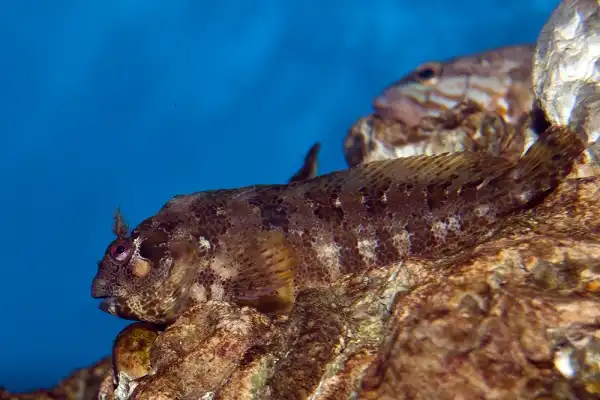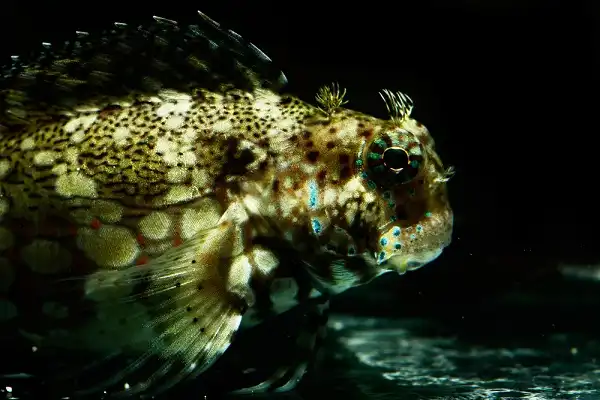Have you ever been captivated by the underwater world of fish? If so, then look no further than the Lawnmower Blenny! The Lawnmower Blenny is a small fish that has captivated aquarists for numerous years with its vibrant colors and interesting behaviors. Not only does this species of blenny boast an impressive array of stripes, spots, and colorful markings – it is also known for its active nature, which can make it extremely entertaining to observe in a home aquarium. Furthermore, due to their size, they are usually well-suited for smaller tanks while most Lawnmower Blennies remain peaceful within an aquarium community as long as they are not crowded or overfed. Read on to learn more about these fascinating creatures!

Lawnmower Blenny Description
The Lawnmower Blenny, also known as Salarias fasciatus, is a popular species of fish among aquarists. Characterized by their vibrant colors, patterned stripes, and spots. The colors of the Lawnmower Blenny may vary, depending on the individual fish, but they often boast a combination of yellow, brown, and green hues on their body. Their interesting behavior and active nature make them a fascinating addition to home aquariums. They have a unique way of moving about, propelling themselves forward by moving their large pectoral fins in a rhythmic motion. Their small size and active nature make them well-suited for smaller tanks, although they do require hiding places and areas to graze.
Lawnmower Blenny Habitat
The Lawnmower Blenny is a small fish species that is commonly found in the Indo-Pacific region. They are usually found in shallow waters near coral reefs, rocky shorelines, and other submerged structures. These fish are well-adapted to living in a variety of reef habitats and can be found in areas with varying water flow and light conditions. In the wild, Lawnmower Blennies are known for their ability to graze on algae that grow on surfaces such as live rock and sand. They have specialized teeth that allow them to scrape and remove algae, which helps to keep the reef ecosystem in balance. Additionally, they seek shelter and hiding places among coral and rocky structures to protect themselves from predators and other threats. In-home aquariums, it is important to provide Lawnmower Blennies with a habitat that closely mimics their natural environment. This means providing ample hiding places such as live rock and artificial structures, as well as areas where they can graze on algae. It is important to note that these fish need a stable environment and good water quality, as they are sensitive to changes in water chemistry and temperature.
Lawnmower Blenny Diet
The Lawnmower Blenny’s herbivorous diet consists mainly of algae growth that forms on surfaces such as live rock, sand, and other substrates. Their specialized teeth allow them to scrape and remove the algae, providing a natural means of keeping aquariums balanced. In addition to their natural grazing habits, they also require supplemental feeding to maintain optimal health. As with all herbivorous fish, it is important to ensure that their diet is varied and nutritionally complete. Lawnmower Blennies can be offered a variety of vegetable matter, such as spirulina flakes, seaweed, blanched lettuce, and spinach. It is essential to avoid feeding them meat-based products or fatty foods, as they are not adapted to process these types of nutrients. To prevent overfeeding, it is recommended to provide small portions of food several times a day, rather than one large feeding. This will help to maintain water quality and prevent the accumulation of uneaten food in the tank. Furthermore, it is crucial to avoid overstocking and overcrowding, as this can lead to competition for food and aggression among tank inhabitants.

Lawnmower Blenny Size
The Lawnmower Blenny is a small fish species that is native to the Indo-Pacific region, typically growing to a maximum size of around 4 inches in length. They have an elongated body shape, with a dorsal fin running the length of their back and a smaller ventral fin underneath. Their coloration ranges from brownish to yellowish-orange on their dorsal side, and white or pale yellow on the underside. They also feature a pair of dark stripes running along the top and bottom of their body, which helps them blend in with the environment when they are hiding among rocks and corals.
Lawnmower Blenny Lifespan
The lifespan of the Lawnmower Blenny is a topic of interest for many aquarium enthusiasts. These fish typically live for up to 5 years in captivity, although some specimens have been known to live for even longer. Water quality is also a crucial factor in the longevity of your Lawnmower Blenny. They require clean and well-oxygenated water with appropriate temperature and salinity levels. A good filtration system, regular water changes, and appropriate tankmates can all contribute to maintaining optimal water quality and thus helping your Blenny thrive. It is also important to ensure that your Lawnmower Blenny has plenty of hiding spots and adequate space to swim around. These fish are active swimmers and need plenty of room to move around, but also require hiding places such as rock crevices or artificial reef structures where they can feel safe and secure from potential threats. By providing them with a balanced diet, optimal water quality, and appropriate living conditions, you can help ensure that your Blenny thrives and contributes to the overall health of your home aquarium.
Lawnmower Blenny Behavior
Lawnmower Blennies are known for their unique behavior and interesting interactions within the aquarium. These small fish are generally peaceful and make excellent additions to a community tank. However, they can be territorial towards other Blennies or similar-looking fish, especially if they are of the same gender. These fish are active swimmers and spend most of their time foraging for food. They are known for their ability to efficiently graze on algae and can help to keep your tank clean from excess algae growth. Additionally, they will often use their fleshy lips to scrape algae off rocks and other surfaces in the aquarium.
Lawnmower Blennies are also known for their unique personality and curious nature. They are often seen swimming around the tank, investigating their surroundings, and interacting with their fellow tank mates. These fish have been known to recognize their owners and may even come to the surface to greet them during feeding times. While generally peaceful, Lawnmower Blennies may become aggressive toward other tankmates if they feel threatened or stressed. It is important to provide them with ample hiding places and plenty of room to swim in order to reduce the likelihood of territorial behavior.

Lawnmower Blenny Speed
The Lawnmower Blenny is an active swimmer that can move very quickly and agilely through the water. This species has been known to reach swimming speeds of up to 4.3 mph, making them one of the fastest fish in the aquarium. In addition to their impressive speed, these fish are also highly mobile and able to navigate tight corners or changes in topography with ease. This agility helps them to find food sources such as algae or small invertebrates and escape from potential predators. Their mobility makes these fish excellent candidates for a reef tank, where they can explore the nooks and crannies of rock formations searching for food. Additionally, this mobility allows Lawnmower Blennies to stay well out of the reach of potential predators or competing fish. Lawnmower Blenny is an incredibly active and mobile species of fish.
Lawnmower Blenny Hunting
Lawnmower Blennies are not predators, but rather herbivores, and they spend most of their time swimming around in search of algae and other plant matter to graze on. They have a unique ability to efficiently scrape and consume algae from surfaces, keeping the tank clean and healthy. As such, they do not exhibit any particular hunting behavior, as they do not actively seek out prey or engage in attacks. To reduce the likelihood of territorial or aggressive behavior, it is essential to provide Lawnmower Blennies with plenty of space to swim in and ample hiding places where they can feel safe and secure. Additionally, maintaining optimal water quality and providing a well-balanced diet is crucial to their overall health and well-being. While Lawnmower Blennies are not predators and do not engage in hunting behavior, they are fascinating and unique additions to any home aquarium. Their efficient grazing abilities and interesting interactions with other tankmates make them valuable members of a community tank, but it is important to provide them with appropriate living conditions to ensure their overall health and well-being.
Lawnmower Blenny as Pets
In addition to their usefulness in the home aquarium, Lawnmower Blennies also make great pets. These fish are relatively hardy and can usually adapt to any environment they’re put in, but it’s still important to provide them with a healthy diet and adequate space to swim around. As long as these conditions are met, they will be happy and active members of your tank. These fish also have interesting behaviors that you can observe if you spend enough time watching them. They often move around quickly and explore their surroundings when looking for food, but they also like to hide away in rocks or crevices when they’re feeling threatened or stressed out. Watching these activities can help you gain insight into their behavior and better understand how they interact with their environment.

Conclusion
The Lawnmower Blenny is an interesting and unique addition to any home aquarium. These peaceful yet active swimmers are known for their efficient grazing abilities, making them valuable members of a community tank. While generally docile, it is important to provide them with ample space and plenty of hiding places to reduce the likelihood of territorial or aggressive behavior. With proper care and attention, these fascinating creatures can thrive and contribute to the overall health of your home aquarium for many years to come.
Frequently Asked Question

